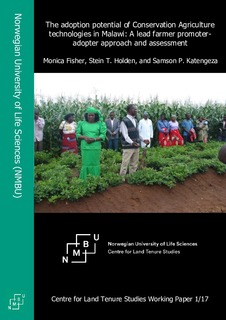| dc.contributor.author | Fisher, Monica | |
| dc.contributor.author | Holden, Stein Terje | |
| dc.contributor.author | Katengeza, Samson P. | |
| dc.coverage.spatial | Malawi | nb_NO |
| dc.date.accessioned | 2018-01-31T12:42:06Z | |
| dc.date.available | 2018-01-31T12:42:06Z | |
| dc.date.issued | 2017 | |
| dc.identifier.uri | http://hdl.handle.net/11250/2480972 | |
| dc.description.abstract | This paper assesses the adoption potential of conservation agriculture (CA) technologies in Malawi, where CA appears highly appropriate. Estimation of CA adoption rates and their determinants is complicated by the relatively recent introduction of these technologies and limited awareness of CA among the general population of smallholder farmers.
We propose a lead farmer promoter-adopter approach and use it to assess the adoption potential of CA among smallholder farmers in Malawi. This approach relies on the promoters being potential adopters themselves, having had sufficient exposure and access to the technologies, and their incentives not having been distorted by excessive incentives. These conditions are reasonably satisfied in our application with a sample of 181 lead farmers from central and southern Malawi.
We find adoption rates for the lead farmers of 56% for organic manure and crop rotation, 26% for minimum tillage, 30% for mulching, and 12% for herbicide application. Lead farmers recommend CA to their followers at rates of 66% for organic manure, about 50% for crop rotation and minimum tillage, 28% for mulching, and less than 10% for herbicide application.
Assuming the validity of the promoter-adopter approach, these findings together suggest that, in central and southern Malawi, organic manure and crop rotation have the highest adoption potential, mulching and minimum tillage come next, and herbicide application has the lowest potential. With the farmer-to-farmer extension approach gaining popularity in many countries, we expect that our promoter-adopter approach to assessing adoption potential of new technologies will be of broad interest. | nb_NO |
| dc.description.sponsorship | CGIAR Independent Science and Partnership Council ; NORHED | nb_NO |
| dc.language.iso | eng | nb_NO |
| dc.publisher | Norwegian University of Life Sciences, Ås | nb_NO |
| dc.relation.ispartofseries | CLTS Working paper;2017:1 | |
| dc.rights | Attribution-NonCommercial-NoDerivatives 4.0 Internasjonal | * |
| dc.rights.uri | http://creativecommons.org/licenses/by-nc-nd/4.0/deed.no | * |
| dc.title | The adoption potential of conservation agriculture technologies in Malawi : a lead farmer promoter-adopter approach and assessment | nb_NO |
| dc.type | Working paper | nb_NO |
| dc.subject.keyword | Conservation agriculture | |
| dc.subject.keyword | Extension approaches | |
| dc.subject.keyword | Technology transfer | |

